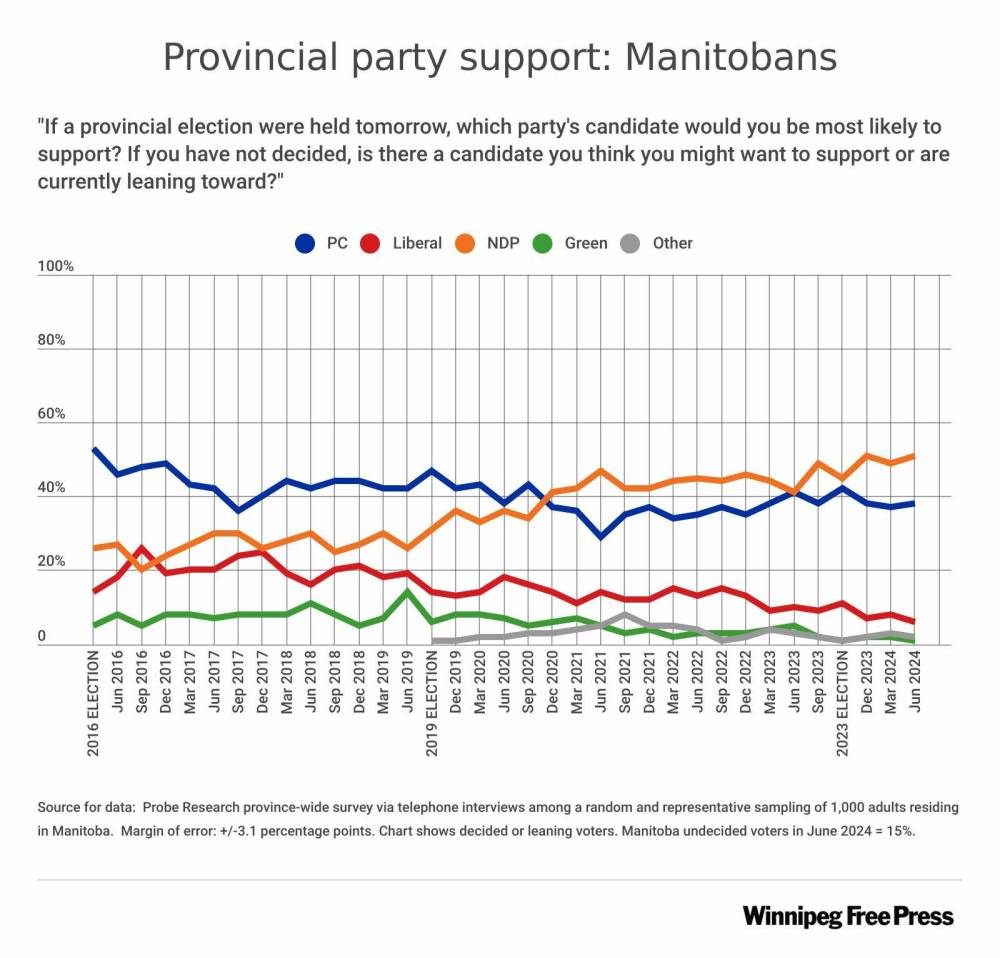Manitoba’s NDP government appears to be doing something right — at least in the eyes of voters.
A Free Press-Probe Research poll released this week shows the NDP continues to have a commanding lead over the Progressive Conservatives, whose popularity has declined inside and outside of Winnipeg.
When asked which party they would support if an election were held today, 51 per cent chose the NDP, 13 percentage points ahead of the Tories. The Liberals, who were decimated in the October provincial election (falling from three seats to one in the legislative assembly) continue to draw only single-digit support at six per cent.
It’s not unusual for a new government to enjoy a honeymoon period following its first electoral victory. But it is rare for a government to keep climbing in popularity eight months after a provincial election.

The NDP has seen its popular support grow six percentage points from 45 per cent during last year’s election. Most of that growth has been in Winnipeg, where the party has seen its numbers climb from 52 per cent during the election to 59 per cent today.
What is remarkable is the NDP has also seen growth in rural Manitoba, where it usually lags well behind the Tories. NDP support outside of Winnipeg grew to 40 per cent from 36 per cent since the October election. It’s still less than the Tories but it’s trending upwards.
By contrast, the former PC government did not grow its popular support following the party’s 2016 electoral victory. The Tories’ popularity began to dip immediately after it won the election, falling from 53 per cent to 49 per cent eight months later. It fell further to 43 per cent after a year in office.
Even the popular NDP government under former premier Gary Doer didn’t see its support grow immediately after it won the September 1999 election, when it defeated the former Filmon government. A year after that election, the NDP held steady at 44 per cent support (the same level it received during the provincial election, although it did win the 2003 election with 49 per cent popular support).
Meanwhile, at 59 per cent support in Winnipeg, the NDP is well-positioned to snatch Tuxedo from the Tories in Tuesday’s byelection to replace former Tory MLA and premier Heather Stefanson. The Tories have never lost that constituency since it was first contested in 1981, but they might this time around.
Stefanson won the Winnipeg seat by 268 votes in last year’s election. Considering Tory support has dropped in Winnipeg since then (down to 29 per cent from 32 per cent), it’s expected to be a tight contest. A loss for the Tories would be devastating. A win for the NDP would strengthen its grip on Winnipeg.
It’s unclear where in Winnipeg NDP support has grown. The Probe poll does break down survey numbers into three areas of Winnipeg: the inner city, inner suburbs (like St. James and St. Boniface) and the outer suburbs, north and south, which includes Tuxedo.
However, the sample size is too small to draw any conclusions (although it is noteworthy that the NDP leads handily in all three regions of Winnipeg).

So what has the NDP done over the past eight months to deserve such a surge in popular support? In many ways, Kinew has taken a page out of the Gary Doer playbook and governed in the middle of the political spectrum, which appears to be bearing fruit for the rookie premier.
The NDP is spending lavishly and has brought in pro-union legislation. But it has also cut taxes (and raised some for higher-income property owners), reduced the deficit, promised to balance the books in its first term and announced several so-called tough on crime measures. It mirrors almost exactly what the former Doer government did in its early days.
What the Kinew government has not done is made progress on its key election promise of fixing health care. Most hospital wait lists are the same or longer than they were eight months ago, including emergency room wait times and long delays getting hip and knee surgery.
Much like the former Doer government (who failed to eliminate so-called hallway medicine and bring down wait times during its time in office), the Kinew government doesn’t seem to be paying a price for its health care failures — at least not yet. Voters are probably willing to give the party a chance, knowing that change in health care takes time.
Either way, barring an unforeseen political calamity, this week’s numbers suggest the NDP should have no problem winning a second term in office in 2027. It’s highly unlikely the stranglehold it has on Winnipeg will subside much over the next three years. This week’s polling numbers are that strong.
tom.brodbeck@freepress.mb.ca

Tom Brodbeck
Columnist
Tom Brodbeck is a columnist with the Free Press and has over 30 years experience in print media. He joined the Free Press in 2019. Born and raised in Montreal, Tom graduated from the University of Manitoba in 1993 with a Bachelor of Arts degree in economics and commerce. Read more about Tom.
Tom provides commentary and analysis on political and related issues at the municipal, provincial and federal level. His columns are built on research and coverage of local events. The Free Press’s editing team reviews Tom’s columns before they are posted online or published in print – part of the Free Press’s tradition, since 1872, of producing reliable independent journalism. Read more about Free Press’s history and mandate, and learn how our newsroom operates.
Our newsroom depends on a growing audience of readers to power our journalism. If you are not a paid reader, please consider becoming a subscriber.
Our newsroom depends on its audience of readers to power our journalism. Thank you for your support.